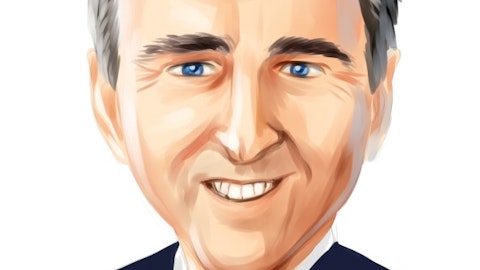To the degree the rate notice is different and positive, then that could change our ability to extract more. But as we said, we need the benefit of the rate notice to fully assess that and are making what we think are reasonable assumptions at this stage. The other thing to keep in mind is with a third of our book risk provider supported, while we will certainly take benefit actions across that book as well, it leads to minimal impact to our earnings. And so the $6 to $10 you can think of is really having to be realized over roughly two thirds of the book. So it does translate into a higher benefit reduction than your math would suggest. And then I do think it’s important to just remind everyone about our commentary this morning that to the degree 2024 does in fact get better, we would expect that to be additive to that $6 to $10 going into next year, because we do intend to price assuming this trend persists.
And so if we see positive development over the course of the year, that would be additive and you would see further appreciation. And just given again, as Bruce said, the recency of these trends, we just are going to need some more time to fully assess that and the likelihood that they will persist for that period of time. But our intention is to be very diligent about restoring margin, and this is our best estimate at this time based on what we know with what we think are reasonable assumptions.
Bruce Broussard: And just on that, Justin, what we are trying to do is be thoughtful around the profitability of the company, and we are committed to getting to restoring our margin, I want to say that. How? If we do, we do that in one year or do we do that in multiple years, is something that we’re really addressing. As we’ve looked at the price elasticity of our members, we’re really also trying to figure out where does it just fall off the cliff as opposed to losing some members or not growing as much. So we are committed to pushing, ensuring that we are going to move the margin, and at the same time, we just don’t want to fall off the cliff and lose hundreds of thousands of members as a result of that. So it is just a question of timing as opposed to a question of trajectory.
Justin Lake: Thanks.
Operator: Our next question comes from the line of Stephen Baxter with Wells Fargo.
Stephen Baxter: Yes, hi. Thank you. So, just another quick one on the magnitude of improvement in 2025 and I think when we looked at what your earnings trajectory was, maybe stepping back a couple of months ago, we would have already thought that you were going to improve earnings around $6 in 2025. So it’s a little hard to feel like the incremental actions you’re taking related to pricing, honestly are really all that material. So we’d love to just get a little bit more color on that? And then just also, your approach to operating expenses in 2024 and 2025, it does look like you have SG&A up $700 million in 2024. I guess I thought there might have been maybe more actions you could take to try to protect earnings in the short-term as you work to reprice. I’d love to just understand that a little better. Thank you.
Susan Diamond: Hi Steve, sure. So I’ll take the operating question. I might need you to clarify your first question on pricing, but on the operating expense, yes. As you saw, and as we’ve been describing all year, as we saw the initially higher outpatient trends starting in the second quarter, we were able to successfully mitigate that pressure that we stepped up to through the third quarter through multiple levers, including administrative cost reductions. And you saw that in the operating cost ratio we reported for 2023, which was certainly favorable relative to the commitment we’ve made for 20 basis points of annual improvement. We certainly continue to work very hard to identify additional opportunities, and our 2024 guide reflects about 30 basis points improvement versus the 20 commitment.
So demonstrating, again, continuing to use that as a way to mitigate some of these trends. We do think there is additional opportunity, particularly leveraging technology, AI, and some other tools. But we recognize they probably have longer timelines to get the full value realization, and so we will continue to build the pipeline. And you should expect us, I think, to see better than the 20 basis point commitment over the next number of years and we’ll certainly work hard over the course of the year to see what potential we have through 2024 and 2025. On the pricing question, would you mind restating that just to make sure I understand what you’re comparing to?
Stephen Baxter: Yes, like I would have thought you would have two or three months ago been going from $31 of earnings to $37 of earnings, so already kind of delivering $6 of incremental earnings. So comparing that trajectory to the trajectory now, you’re talking about kind of an incremental 0 to 4. That perspective is kind of what I’m trying to get at is why couldn’t you do more quickly to kind of accelerate the trajectory?
Susan Diamond: Yes, so I think obviously what we’re dealing with is this higher trend, which is significant. And so when you think about over the course of 2023 since the time of pricing, it’s about $3 billion of additional trend that’s emerged that we’re having to absorb in 2024. And again, our assumption right now is that will continue and will have to be absorbed in our 2025 pricing. And so that is where we will certainly take as much pricing action as we can. We will have to see the right environment, but there is a limit to what you can do in one year. And with that level of trend, which was never contemplated in the $31, there’s only so much margin expansion you can get once you actually cover the trend. Now, over the long-term, as Bruce alluded to, there are inherent mechanisms where it will work its way into the rates.
It takes a little bit longer for the benchmarks to reflect the higher rates. So that is certainly something we’ll see in the future. And to the degree any of this is attributable to higher acuity or condition development, et cetera, we should see that in risk adjustment over time as well. Those are all things that will take more time to assess and we’ll certainly consider. But for right now, with our assumptions for 2025 and the timeline, we’ll have to cover the trend and then again do as much as we can on the margin expansion as we committed to today.
Operator: Our next question comes from the line of Ann Hynes with Mizuho.





